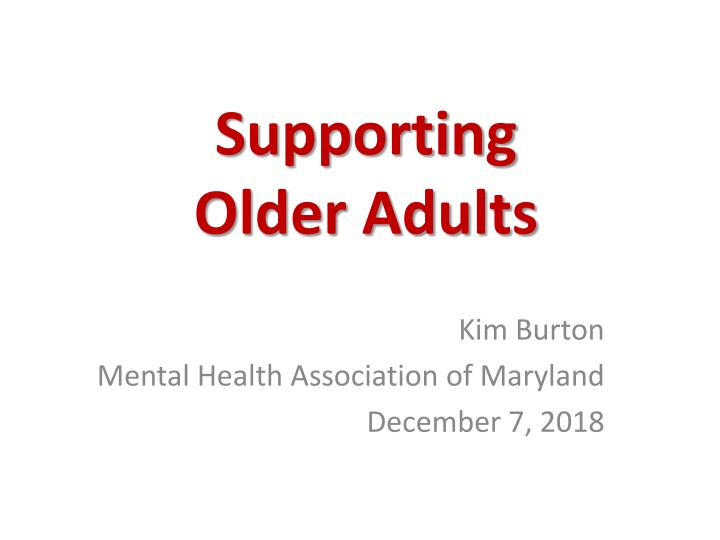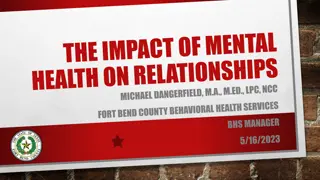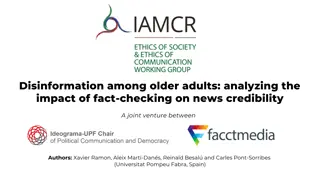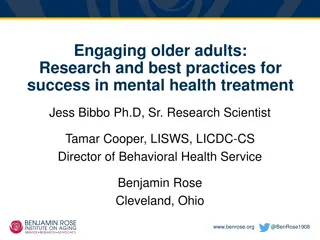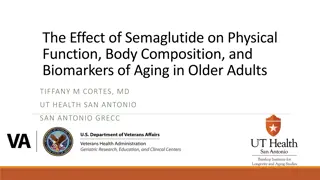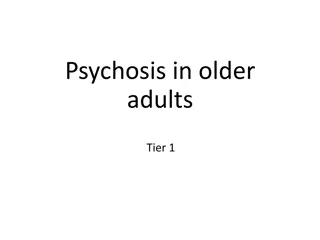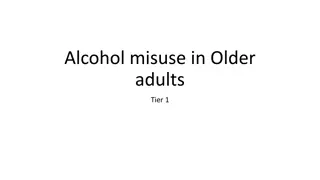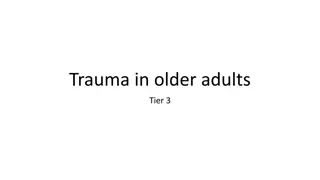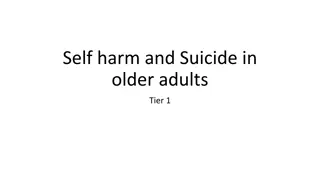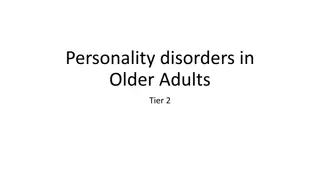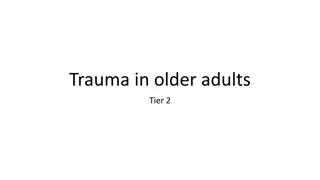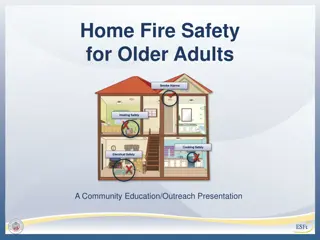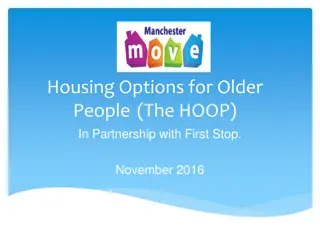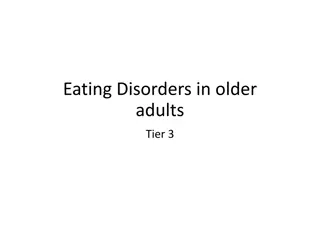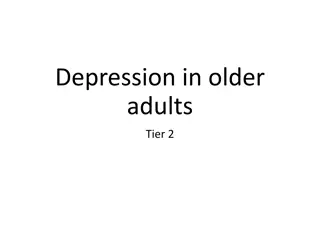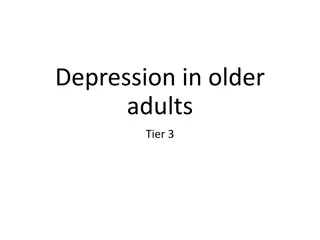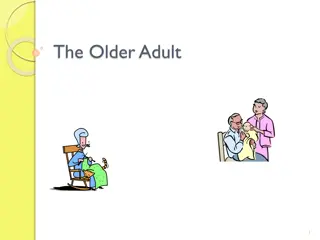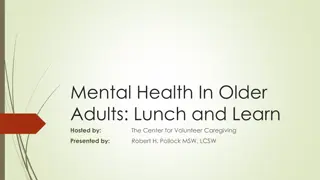Addressing Mental Health Challenges in Older Adults
Understanding the mental health challenges faced by older adults is crucial as they navigate through different stages of aging. Issues, vulnerabilities, and risk factors associated with aging can impact their well-being. From age-related vulnerabilities to under-identified and under-treated conditions, various factors contribute to the prevalence of psychiatric disorders in this population. Recognizing these challenges and promoting awareness can help enhance support systems and improve the quality of life for older adults.
Download Presentation

Please find below an Image/Link to download the presentation.
The content on the website is provided AS IS for your information and personal use only. It may not be sold, licensed, or shared on other websites without obtaining consent from the author.If you encounter any issues during the download, it is possible that the publisher has removed the file from their server.
You are allowed to download the files provided on this website for personal or commercial use, subject to the condition that they are used lawfully. All files are the property of their respective owners.
The content on the website is provided AS IS for your information and personal use only. It may not be sold, licensed, or shared on other websites without obtaining consent from the author.
E N D
Presentation Transcript
Supporting Older Adults Kim Burton Mental Health Association of Maryland December 7, 2018
The "Young Old" 65-74 10,000 new retirees will be added to the Social Security and Medicare rolls each day. During the next decade, increased life expectancy will strengthen the wave of aging Boomers The "Old"74-84 The fastest-growing segment of the total population is the oldest old those 80 and over. Their growth rate is twice that of those 65 and over and almost 4-times that for the total population. This group will more than triple from 5.7 million in 2010 to over 19 million by 2050. (transgenerational.org) The "Oldest-Old" 85+
Estimated Prevalence of Major Psychiatric Disorders by Age Group 16 15 14 13 Millions 12 11 10 9 8 18-29 30-44 45-64 65 > 7 2000 2010 2020 2030 Jeste, Alexopoulus, Bartels, et al., 1999
Issues Vulnerabilities Risk Factors
Age Related Vulnerabilities Common experiences in later life raise the risk that someone will develop a behavioral health disorder or worsen existing problems Physical Functional Social Mental Emotional
Change Can Become Risks Health Memory Changes to self esteem Family dynamics Dependence on others Social network Marital status Role in community Senses Physical appearance Leisure time Employment Metabolism Mobility Residence Loss of loved ones Financial circumstances Insurance concerns
Later Life Risk Factors Illness diabetes, heart disease, cancer, stroke Serious disability, Conditions that are painful Sensory loss Sleep problems Cognitive impairment Polypharmacy Compounded / significant loss and stress Fewer resiliency / adaptation / coping skills
Under Identified and Under Treated More than 80% with need DO NOT get help: Don t know of elevated risk, don t know symptoms, don t know how to get help Symptoms mimic chronic health conditions Screening and assessment is not routine Diagnostic criteria inappropriate Physician discomfort , lack of geriatricians Fear of myths and lack of support
Trauma Individual trauma results from an event, series of events or set of circumstances that is experienced by an individual as overwhelming or life-changing and that has profound effects on the individual s psychological development or well-being. Community trauma is experienced by a group, can be multi-generational and may be normalized. (U.S. Substance Abuse and Mental Health Services Administration)
Recovery Dimensions (SAMHSA) Health overcoming or managing disease or conditions, making informed & healthy decisions in support of well-being Home a stable & safe place to live Purpose meaningful activities & the independence &resources to participate Community - relationships and social networks for support, friendship, love & hope
National Survey on Drug Use and Health projects the number of adults age 50+ years with a substance use disorder to double from 2.8 million in 2002-2006 to 5.7 million in 2020
More than 25% of older adults use prescription psychoactive medications that have abuse potential
Impact of Problem on Older Adults Negative psychoactive medication effects include low motivation, memory problems difficulty with ADLs and social withdrawal Benzodiazepines associated with mental health problems, cognitive decline, confusion, falls, hip fractures Opioid / narcotic analgesics associated with excessive sedation, respiratory depression, vision impairment, poor attention and coordination, falls
Non-medical use of prescription drugs is estimated to increase 100% among older adults between 2001 and 2020 Misuse occurs by patient and by practitioner 121% increase in ED visits involving Rx drug misuse (2004-2008)
NIAA recommends no more than one drink per day after age 65
Levels of Use Low Risk: no problems setting limits At-Risk: 7-10 drinks/week or drinks in risky situations, if patterns continue problems are likely to result Problem Use: already resulting in medical, psychological or social problems needs assessment Dependence: loss of control, preoccupation with alcohol, continued use despite problems, difference in tolerance, withdrawal
Men and women aged 60 and older who drink more than 7 drinks per week have greater impairments in instrumental activities of daily living (IADLs) .. More than 3 drinks per occasion is associated with IADL impairment among older adults. Older Americans Behavioral Health Technical Assistance Center Issue Brief 2: Alcohol Misuse and Abuse Prevention
Factors Associated with Risk Females (psychoactive medication misuse / abuse) Male (alcohol misuse / abuse) Social isolation Personal / family history of substance abuse Mental health / sleep / pain disorder Compounding stressors / losses Unstructured time
Impact of Problem on Older Adults Drinking alcohol can worsen: Diabetes High blood pressure Congestive heart failure Liver problems Osteoporosis Memory problems Mood disorders
Guidelines for older adults: Avoid alcohol if taking central nervous system depressants, psychiatric medications, analgesics, anticoagulants, antidiabetic drugs, or cardiovascular drugs. Always check with pharmacist. Avoid alcohol consumption immediately before going to bed in order to avoid sleep disturbances. Avoid alcohol if driving.
Guidelines for older adults cont. Avoid alcohol if there is mild cognitive impairment / dementia Avoid alcohol if there is a history of falls or unsteady walking
Problematic Outcomes Reduced activity, functional impairments Disturbed relationships Diminished quality of life Exacerbated health problems Premature institutionalization or death (suicide)
Untreated or inadequately treated pain, anticipatory anxiety of the progression of illness, fear of dependence on others and fear of burdeningone s family are the major contributing factors in the suicidality of older adults that have a physical illness.(Szanto et al., 2002)
Early Identification of a Problem Warning Signs: Withdrawal from people and activities Change in attitudes and behaviors (negative thinking, excessive, worry, loss of motivation, short temper, agitation, problems with memory / judgment / thinking) Mood swings Complaints of pain Changes in appetite and sleep patterns
Signs & Symptoms Bumps, bruises, falls that are unexplained or suspicious Slurred speech, impaired balance Memory loss, black outs, vague recollections Depressed mood, anxiety, hostility Behavioral changes Empty bottles, multiple medications Isolation Denial
Signs & Symptoms Medical problems complaints of gastrointestinal disturbances, fatigue, insomnia, malnutrition, hypertension, unstable diabetes Ignores warning labels on prescription drugs does not take as directed Neglect of personal appearance and dramatic weight fluctuations
Solutions Innovative screening, prevention, intervention and treatment methods for alcohol and drug misuse among older adults are available and effective. SAMHSA
Solutions: Screen and Assess SBIRT Alcohol Use Disorders Identification Test (AUDIT) developed by WHO as a brief screen for excessive drinking Short Michigan Alcoholism Screening Test Geriatric Version (SMAST-G) ASSIST drug use questionnaire adapted to target psychoactive meds
Screening All adults over 60 should be screened as part of regular physical exam Rescreen when there are major life changes / transitions or compounding stressors Rescreen if the following symptoms present: Sleep related problems Cognitive difficulties Seizures, malnutrition, muscle wasting
Screening Rescreen if: Persistent irritability or altered mood Unexplained complaints of chronic pain Incontinence, urinary retention Poor hygiene and self neglect Complaints of blurred vision or dry mouth Unexplained nausea and vomiting Tremors, poor motor coordination, shuffling gait Frequent falls or unexplained bruising
Solution: Sensitive Approach Use sensitive language Describe impact of substances on health and functional status State likely health and function gains to result from addressing problematic use Invite older adults to identify goals, assess health habits and contribute to solutions Remain non-confrontational, supportive and hopeful
Treatment and Recovery Medical oversight potentially necessary Multidisciplinary approach should include support team (family / caregivers) Culturally appropriate, age specific and non- confrontational group treatment that aims to build / rebuild self esteem and support system Address and mitigate physical and psychosocial challenges Work on coping and resiliency skills Build on strengths
Hope Hope, the belief that these challenges and conditions can be overcome, is the foundation of recovery. A person s recovery is built on his or her strengths, talents, coping abilities, resources and inherent values. It is holistic, addresses the whole person and their community and is supported by peers, friends and family members. (SAMHSA)
National Council on Aging, Center for Healthy Aging, Older Americans Behavioral Health Issue Brief Series www.ncoa.gov US Department of Health and Human Services Centers for Disease Control and Prevention Substance Abuse and Mental Health Services Administration National Survey on Drug Use and Health (2007, 2009) CSAP Pathways Courses National Coalition on Mental Health and Aging http://www.ncmha.org/resources.php
